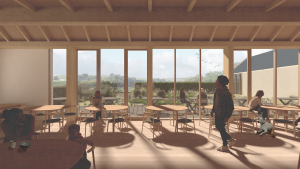Ambitious plans to safeguard the only farm built by Robert Burns have received overwhelming public support.
A digital engagement exercise found almost 90% backing for proposals to preserve and improve Ellisland Farm beside the River Nith where Burns wrote Auld Lang Syne and Tam o Shanter.
Robert Burns Ellisland Trust, the charity behind the Ellisland FutureVision, want new generations of artists and musicians to work in the landscape that inspired the national bard, and also to create holiday accommodation and event hire to make the site sustainable.
The 1788 cottage would be brought back to its original state, with other historic buildings converted to host educational and community activity. Biodiversity would be enhanced by woodland management and native cultivation.
The digital engagement exercise found 96% agreed that conservation and education work should be subsidised by activities such as tourism and events, an approach known as “conservation through use.”
More than 92% agreed the cottage built by Burns for his young wife Jean Armour, which currently houses the museum and staff accommodation, should be returned to its original state to create an “immersive” experience for visitors.
Almost 96% agreed that the barns and byres, which are well preserved but in need of urgent repair, should be restored to host workshops and events to celebrate the spirit of Burns in music, writing and culture.
More than 86% agreed with the trust’s proposals to create a newly built visitor centre to house the important collection comprising the poet’s personal possessions and manuscripts. The visitor centre will also include a cafe and outside play space. The FutureVision aims to boost the Dumfries and Galloway economy with a heritage attraction of national and international significance.
The proposals include artistic retreats in “tiny house” accommodation inspired by the hermitage, the bothy in neighbouring Friars Carse estate where Burns would retreat to write. The new hermitages would be in converted historic outbuildings as well as off grid.
Joan McAlpine, Project Director at the Robert Burns Ellisland Trust, said the overwhelming support demonstrated the value people placed on Burns and his legacy.
“We are very grateful to everyone who responded to the digital survey and who visited us on site for the engagement day too. It is very clear that people understand the power of the poet in generating economic benefits for Scotland generally and Dumfries and Galloway in this instance.
“The public agree with us that this precious heritage should be preserved but also help new generations be inspired and improve the wellbeing of local people, especially young people. We already maintain access to the riverside walks created by Burns, which is a valuable public amenity. But this site is at risk and only an ambitious plan such as our FutureVision can secure it, by making it financially and environmentally sustainable.
“Since the new trust took over in 2020, we have reached out to the community with our open days, cultural events and school visits programme. But to build on that, we need significant investment to create a world class heritage attraction which will attract people to the area from around the globe.”
The trust will now begin fundraising to take the plans to the next level, including an application to the National Lottery Heritage fund.
The digital engagement exercise was conducted by Dumfries based independent consultancy, Indigo Words, and funded by a Community Led Vision Challenge Fund grant from Dumfries and Galloway Council.
Last year, a report by historic buildings experts Adams Napier funded by Historic Environment Scotland found the site to be of exceptional cultural significance and the best preserved of all Burns’ homes. But a condition survey in the same report warned the historic buildings were at risk and required extensive repairs.
The FutureVision plans were drawn up for the trust by Delfinity Ltd consultants and OCA architects. The FutureVision Project was funded by South of Scotland Enterprise, The Holywood Trust and the Architectural Heritage Fund.





